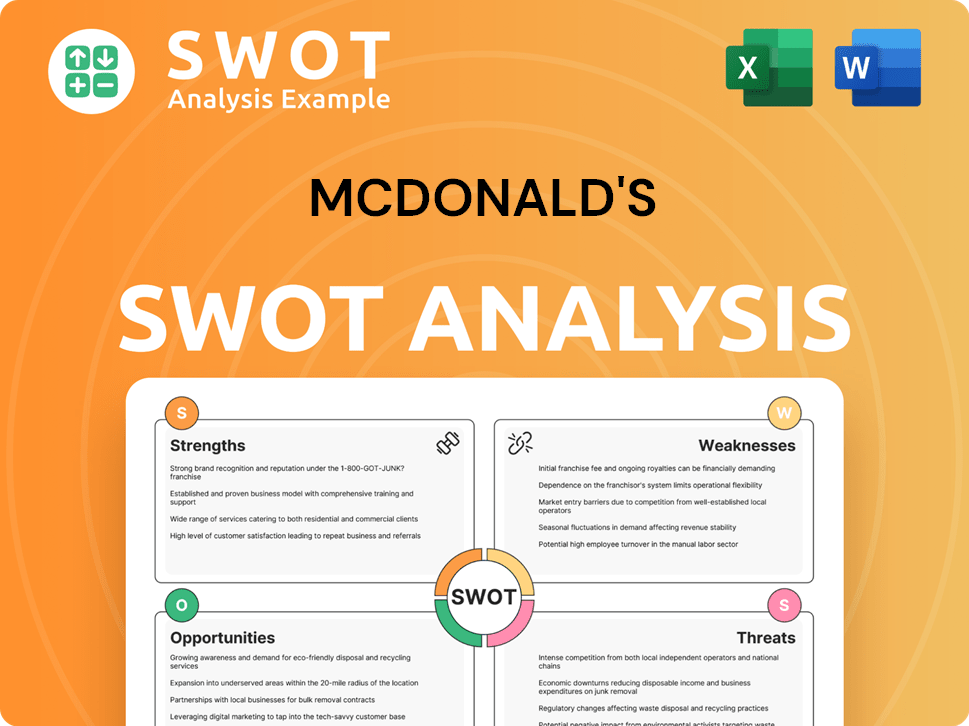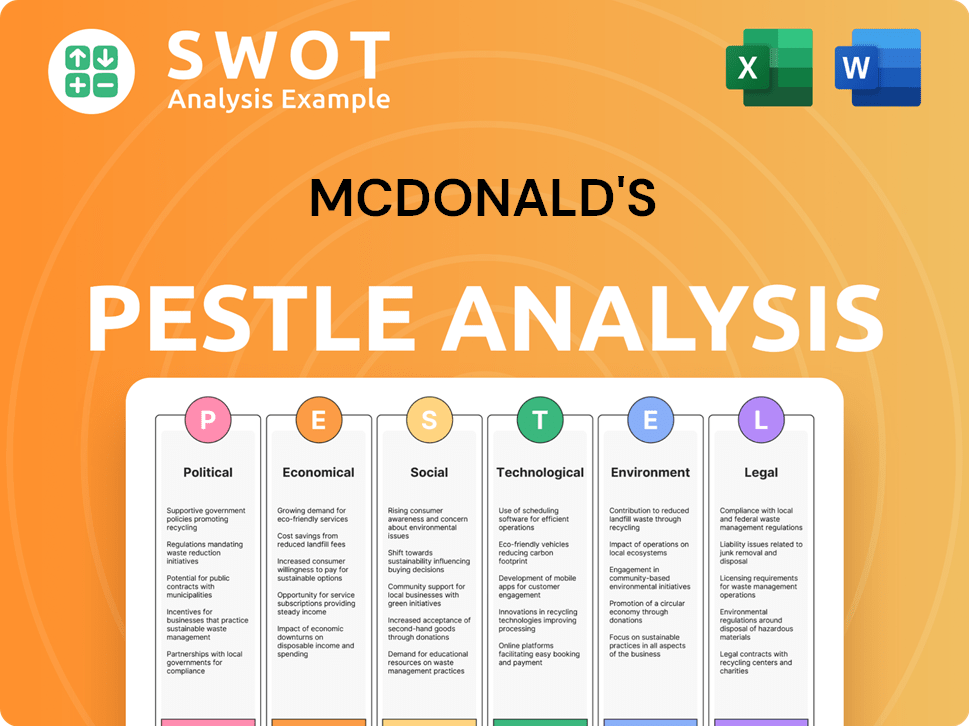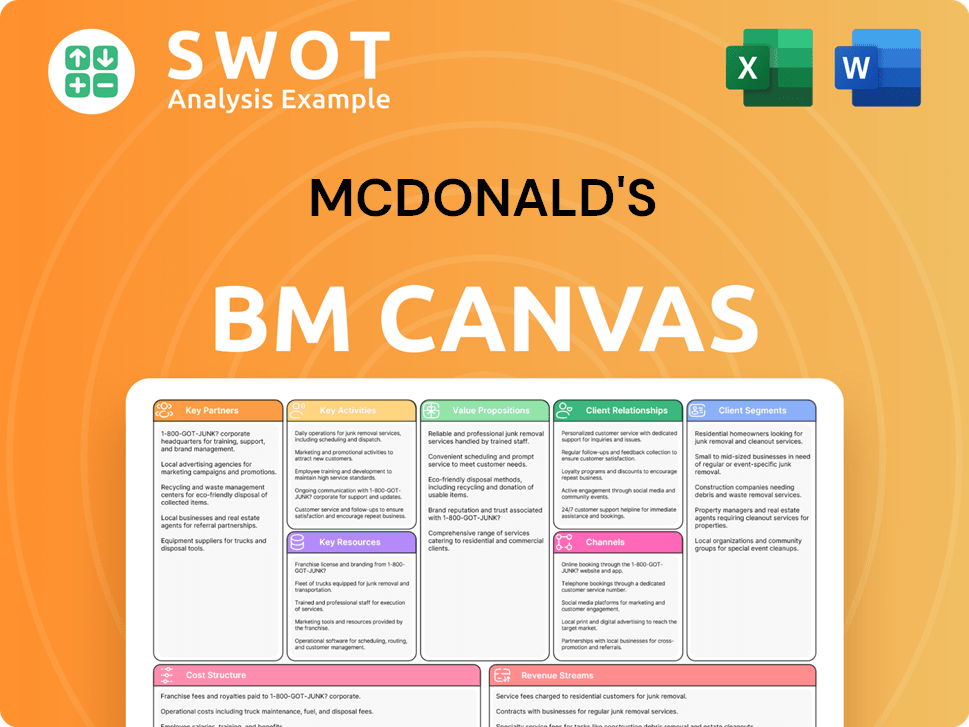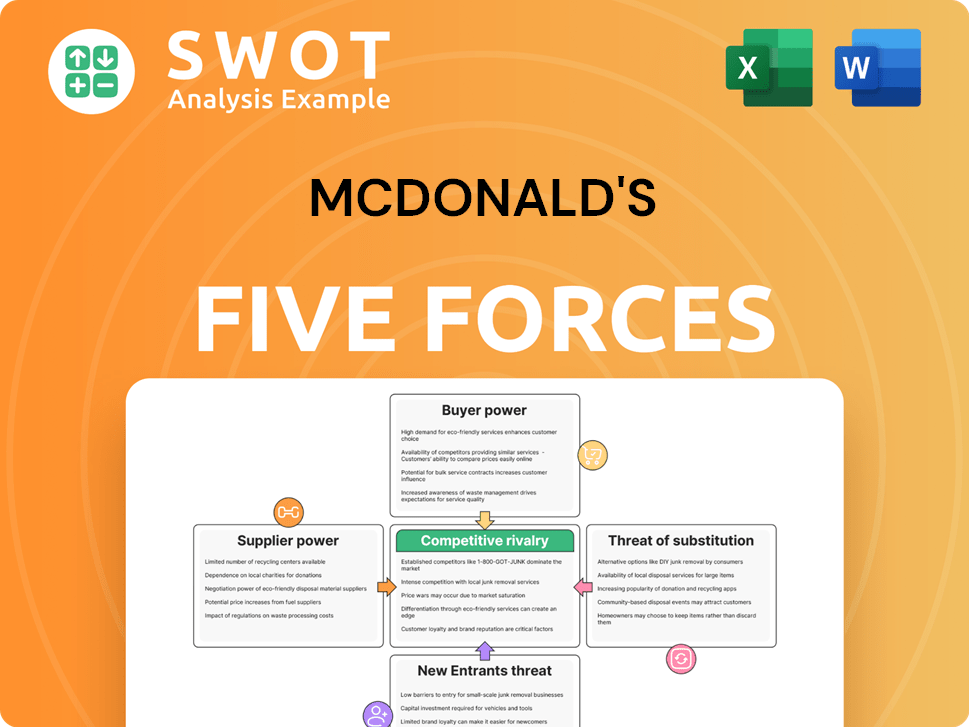McDonald's Bundle
How Did McDonald's Become a Global Giant?
Journey back in time to uncover the McDonald's SWOT Analysis and its fascinating origin story. From a single drive-in to a global empire, the evolution of McDonald's is a compelling narrative of innovation and strategic brilliance. Explore the early days of McDonald's and witness how a simple idea transformed the fast food industry forever. Discover the key moments that shaped McDonald's history and its enduring impact on American culture and beyond.

McDonald's history begins with the McDonald's brothers story, who pioneered the 'Speedee Service System' in the early days of McDonald's, revolutionizing food preparation. This focus on efficiency, coupled with the vision of Ray Kroc, fueled the expansion of McDonald's restaurants across the United States and then globally. Understanding McDonald's origins is key to appreciating its significant milestones and its role in the fast food industry.
What is the McDonald's Founding Story?
The story of McDonald's begins on May 15, 1940, when brothers Richard and Maurice McDonald officially founded the company. Their journey started in Manchester, New Hampshire, but they later moved to California in the late 1920s, initially aiming to break into the film industry before pivoting to the restaurant business.
Their initial ventures included a hot dog stand and a barbecue drive-in, which provided them with valuable experience in the food service sector. The brothers recognized the need for faster service, which led them to revolutionize their business model.
In 1948, the brothers introduced the 'Speedee Service System,' a groundbreaking approach focused on a limited menu of high-volume items like hamburgers, fries, and milkshakes, all prepared with assembly-line efficiency. The first product offered under this new system was the hamburger, priced at just 15 cents. This innovation eliminated the need for carhops and dishwashers, significantly reducing overhead and setting the stage for the fast-food industry as we know it today.
The McDonald brothers' vision transformed the food industry. Their innovative 'Speedee Service System' and focus on efficiency laid the foundation for the modern fast-food model.
- The McDonald's name reflected their surname, creating a straightforward brand identity.
- The post-World War II economic boom and the rise of car culture provided a favorable environment for their business to thrive.
- Initial funding came from the brothers' earnings, essentially bootstrapping the new concept.
- Their expertise in streamlining operations and challenging norms was crucial to their success.
The company's name, 'McDonald's,' was a straightforward reflection of the founders' surname. The post-World War II economic boom and the rise of car culture in America provided a favorable environment for their fast and convenient food service model to flourish. The early success of McDonald's, its impact on the Competitors Landscape of McDonald's, and its subsequent expansion are key aspects of its corporate history.
McDonald's SWOT Analysis
- Complete SWOT Breakdown
- Fully Customizable
- Editable in Excel & Word
- Professional Formatting
- Investor-Ready Format

What Drove the Early Growth of McDonald's?
The early growth and expansion of the company, a key part of the company's history, was significantly shaped by the Speedee Service System and the involvement of Ray Kroc. Kroc, initially a milkshake machine salesman, recognized the potential for nationwide expansion after observing the efficiency of the original operations. His partnership and subsequent leadership were pivotal in transforming the company into a fast food industry leader.
The success of the company is closely tied to the Speedee Service System, which emphasized efficiency and speed. Ray Kroc, after seeing the original operations, became the franchising agent in 1955. The first restaurant under Kroc's management opened on April 15, 1955, in Des Plaines, Illinois, marking a significant moment in the company's timeline and its expansion.
Kroc's vision was to establish a location in every community across America. Early expansion focused on replicating the simplified menu and maintaining consistency. By 1959, the company had opened its 100th restaurant, showcasing rapid market acceptance. The role of franchising was crucial in this early growth phase, providing capital and driving expansion.
The establishment of the McDonald's Corporation in 1961, including the buyout of the McDonald brothers for $2.7 million, gave Kroc full control. This strategic move allowed for significant capital raises through franchising fees and public offerings. The company's growth was fueled by standardized operations and aggressive marketing strategies.
In the emerging fast food industry, the company quickly established itself as a leader, emphasizing consistency, affordability, and convenience. This business model, developed in the early days of the company, would become a hallmark of its global success. For more insights, consider reading about the Marketing Strategy of McDonald's.
McDonald's PESTLE Analysis
- Covers All 6 PESTLE Categories
- No Research Needed – Save Hours of Work
- Built by Experts, Trusted by Consultants
- Instant Download, Ready to Use
- 100% Editable, Fully Customizable

What are the key Milestones in McDonald's history?
The McDonald's history is a narrative of strategic growth and adaptation, marked by key milestones that have shaped the McDonald's origins and its evolution within the fast food industry. The McDonald's timeline is a testament to its enduring influence, from its humble beginnings to its global presence today.
| Year | Milestone |
|---|---|
| 1940 | Richard and Maurice McDonald open the first restaurant in San Bernardino, California. |
| 1948 | The McDonald brothers introduce the 'Speedee Service System,' revolutionizing food preparation. |
| 1954 | Ray Kroc partners with the McDonald brothers, beginning the franchise expansion. |
| 1955 | McDonald's company founding date: Ray Kroc establishes McDonald's System, Inc. (later McDonald's Corporation). |
| 1961 | Hamburger University is established to train franchisees and managers. |
| 1967 | The Big Mac is introduced, becoming an iconic menu item. |
| 1971 | The Egg McMuffin is introduced, expanding breakfast offerings. |
| 1975 | The first drive-thru is introduced, enhancing customer convenience. |
| 2024 | McDonald's announces plans to open 10,000 new restaurants by 2027, focusing on international expansion and digital growth. |
McDonald's restaurants have consistently introduced innovations to enhance customer experience and operational efficiency. The company has secured patents related to kitchen equipment and operational processes, further optimizing its service and efficiency, and has also pioneered the drive-thru concept, enhancing convenience for customers.
Introduced in 1948, this system revolutionized food preparation through assembly-line principles, enabling rapid service. This innovation was a cornerstone of McDonald's early success.
Established in 1961, this training facility ensured consistency across the growing network of franchisees and managers. It played a crucial role in maintaining quality and brand standards.
The introduction of the Big Mac in 1967 and the Egg McMuffin in 1971 revolutionized the menu. These items became industry benchmarks and significantly boosted sales.
Pioneering the drive-thru concept enhanced customer convenience. This innovation significantly increased order volume and speed of service.
McDonald's has invested heavily in technology for order efficiency, including mobile ordering and self-service kiosks. These efforts aim to streamline operations and improve customer experience.
The company has expanded its menu to include healthier options, catering to changing consumer preferences. This strategy aims to attract a broader customer base.
Despite its success, McDonald's has faced several challenges over the years. Market downturns and economic recessions have impacted consumer spending on dining out, and competitive threats from other fast-food chains and healthier food options have necessitated strategic pivots.
Economic downturns have affected consumer spending on dining out, leading to fluctuations in sales. McDonald's has adapted by offering value meals and promotions.
Competition from other fast-food chains and the rise of healthier food options have intensified. McDonald's has responded with menu diversification and marketing campaigns.
Some menu additions have not performed well, requiring the company to adjust its offerings. McDonald's carefully tests new products before widespread release.
Internal crises related to labor practices and public perception regarding health and environmental impact have posed challenges. The company has implemented changes to address these issues.
Growing concerns about health and environmental impact have prompted McDonald's to focus on sustainability initiatives. This includes sourcing sustainable ingredients and reducing waste.
McDonald's has undertaken major strategic repositioning efforts, including menu diversification to include healthier options and investments in technology for order efficiency. This demonstrates its adaptability.
In response to these challenges, McDonald's has undertaken significant strategic repositioning efforts, including menu diversification and investments in technology. For more insights into McDonald's strategies, explore the Growth Strategy of McDonald's. The company's commitment to innovation and customer responsiveness continues to drive its evolution, ensuring its ability to adapt to changing consumer demands and market dynamics. In 2024, McDonald's plans to open 10,000 new restaurants by 2027, emphasizing international expansion and digital growth, showcasing its adaptability and commitment to future growth.
McDonald's Business Model Canvas
- Complete 9-Block Business Model Canvas
- Effortlessly Communicate Your Business Strategy
- Investor-Ready BMC Format
- 100% Editable and Customizable
- Clear and Structured Layout

What is the Timeline of Key Events for McDonald's?
The McDonald's history is a fascinating journey of innovation and expansion within the fast food industry. From its humble beginnings to its global presence, the company has consistently adapted to changing consumer preferences and market dynamics. The early days of McDonald's saw the establishment of the first McDonald's restaurant location, setting the stage for a fast-food revolution. The story of the McDonald's brothers, and later Ray Kroc, is a key part of the company's origins and its evolution into a global icon. The company's significant milestones reflect its strategic decisions and market adaptations over the years.
| Year | Key Event |
|---|---|
| 1940 | Richard and Maurice McDonald opened their first restaurant in San Bernardino, California. |
| 1948 | The brothers introduced the 'Speedee Service System,' revolutionizing fast food. |
| 1955 | Ray Kroc opened his first McDonald's in Des Plaines, Illinois, marking the start of the franchise system. |
| 1961 | Ray Kroc bought out the McDonald brothers for $2.7 million and established Hamburger University. |
| 1967 | The Big Mac was introduced to the menu. |
| 1971 | The Egg McMuffin was introduced, expanding breakfast offerings. |
| 1984 | McDonald's served its 50 billionth hamburger. |
| 2003 | 'I'm Lovin' It' campaign was launched, becoming one of the most recognizable slogans. |
| 2015 | All-day breakfast was introduced in the U.S. |
| 2018 | McDonald's announced its 'Velocity Growth Plan,' focusing on digital, delivery, and experience of the future. |
| 2020 | McDonald's celebrated its 80th anniversary amidst the global pandemic, adapting operations for safety and convenience. |
| 2024 | McDonald's projects opening 10,000 new restaurants by 2027, with significant growth in international markets like China and India, aiming for 50,000 restaurants globally. |
| 2025 | Continued focus on digital transformation, including AI-powered drive-thrus and personalized ordering experiences. |
McDonald's is heavily investing in digital transformation. This includes AI-powered drive-thrus and personalized ordering experiences. The company aims to enhance operational efficiency and customer experience through technology. This strategy is part of their 'Accelerating the Arches' plan for growth.
McDonald's plans significant international expansion, particularly in high-growth markets. The company aims to open approximately 2,000 new restaurants in 2024, with about 1,600 located internationally. They are targeting 50,000 restaurants globally by 2027.
McDonald's is focused on adapting its menu to meet evolving consumer tastes. They are exploring new menu items to cater to changing preferences. This approach is essential for staying competitive in the fast food industry and maintaining customer appeal.
The company is responding to industry trends, including the increasing demand for convenience and sustainable practices. They are likely to integrate more sustainable practices into their operations. This includes efforts to reduce waste and improve sourcing practices.
McDonald's Porter's Five Forces Analysis
- Covers All 5 Competitive Forces in Detail
- Structured for Consultants, Students, and Founders
- 100% Editable in Microsoft Word & Excel
- Instant Digital Download – Use Immediately
- Compatible with Mac & PC – Fully Unlocked

Related Blogs
- What is Competitive Landscape of McDonald's Company?
- What is Growth Strategy and Future Prospects of McDonald's Company?
- How Does McDonald's Company Work?
- What is Sales and Marketing Strategy of McDonald's Company?
- What is Brief History of McDonald's Company?
- Who Owns McDonald's Company?
- What is Customer Demographics and Target Market of McDonald's Company?
Disclaimer
All information, articles, and product details provided on this website are for general informational and educational purposes only. We do not claim any ownership over, nor do we intend to infringe upon, any trademarks, copyrights, logos, brand names, or other intellectual property mentioned or depicted on this site. Such intellectual property remains the property of its respective owners, and any references here are made solely for identification or informational purposes, without implying any affiliation, endorsement, or partnership.
We make no representations or warranties, express or implied, regarding the accuracy, completeness, or suitability of any content or products presented. Nothing on this website should be construed as legal, tax, investment, financial, medical, or other professional advice. In addition, no part of this site—including articles or product references—constitutes a solicitation, recommendation, endorsement, advertisement, or offer to buy or sell any securities, franchises, or other financial instruments, particularly in jurisdictions where such activity would be unlawful.
All content is of a general nature and may not address the specific circumstances of any individual or entity. It is not a substitute for professional advice or services. Any actions you take based on the information provided here are strictly at your own risk. You accept full responsibility for any decisions or outcomes arising from your use of this website and agree to release us from any liability in connection with your use of, or reliance upon, the content or products found herein.